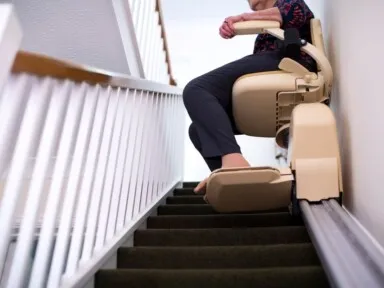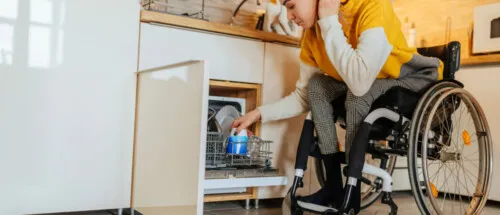Bringing a stair lift into your home provides a safe solution for individuals with limited mobility to ascend the stairs safely, allowing them access to other parts of the home that might otherwise be inaccessible. If you haven’t had a lift in your home before, understanding stair lift installation and the full process—from planning to implementation—can be overwhelming.
Not only that but regular maintenance is required, much like any other household appliance or mobility device. Here is what to expect during your installation and beyond!
In this article:
- What Is a Stair Lift?
- How Does a Stair Lift Work?
- Benefits of Installing a Stair Lift
- How to Choose the Right Stair Lift for Your Home
- The Stair Lift Installation Process
- Financing for Stair Lift Installation
- Stair Lift Maintenance and Longevity
- Frequently Asked Questions
What Is a Stair Lift?
As its name implies, a stair lift is a motorized chair or platform that carries an individual up a set of stairs. These lifts come in a range of styles and make it possible for individuals to access the upper or lower parts of their homes without risking injury from stair-related falls.
These stair lifts can follow either straight or curved stairs and can be installed outdoors as well.
- Straight stair lifts are the most common and the easiest to install.
- Curved stair lifts, which follow the unique curve of a staircase, are a little more expensive.
- Outdoor stair lifts are available in both straight and curved options, and are built to help withstand the elements outside.
How Does a Stair Lift Work?
Stair lifts work by providing a motorized chair for users to sit in that has a seat belt for safety. After sitting down and fastening the seat belt, the user indicates which direction they want to move in, and the stairlift traverses up or down the track. These mounted chairs can be customized to the needs of the household members, allowing them greater accessibility.
The Basic Components of a Stair Lift
- Rail system: Installed along the side of the staircase, it attaches to the chair or platform itself. This mechanized element moves the seat up or down the stairs.
- Seat: A range of seat types are available to suit users’ individual needs.
- Angled: This is a slightly recumbent seat that helps prevent falling or losing balance.
- Collapsible: A seat that can be folded for space-saving storage.
- Perch: A small seat that helps the user remain in an upright, almost-standing position.
- Swiveled: A swivel seat that can be turned up to 90 degrees away from the stairs to help prevent falling.
- Footrest: The footrest can be made larger and with the ability to fold manually or automatically.
- Control systems: Stair lifts are either operated with electricity or battery-powered.
- Electricity: An electric stair lift may be more expensive up front, but it does not require the ongoing cost of battery replacement. However, it is inoperable during a power outage.
- Battery: These lifts aren’t reliant on the power grid, which means they still work during outages. However, replacing the batteries can make them more expensive over time.
Safety Features of Modern Stair Lifts
- Seatbelt: An integrated seatbelt enhances user safety by helping prevent accidental falls during use.
- Obstruction sensors: Built-in sensors stop the lift if an object or person obstructs the track, helping prevent injuries.
- Emergency stop buttons: A manual stop function allows users to halt the stair lift immediately in case of an emergency.
Benefits of Installing a Stair Lift
Increased Accessibility and Mobility
Installing a stair lift in your home means more freedom, independence, and safety. It allows individuals to stay in their beloved homes longer while helping improve accessibility for years to come. When different levels of a home can be accessed more safely with a stair lift, people with mobility needs may feel more peace of mind in knowing they’re not limited to just one level of their residence.
Safety and Prevention of Falls
Particularly with built-in safety features like seatbelts and swiveling seats, stair lifts are excellent mobility solutions for helping to prevent falls. Since users can avoid the physical strain of climbing the stairs and instead remain securely seated, the likelihood of falling is significantly reduced. According to the National Institutes of Health, stairway falls are a leading cause of fatality for seniors, which makes any fall prevention paramount.
Independence for the Elderly and Disabled
The accessibility provided by stair lifts extends beyond physical access—it helps enhance overall quality of life. These devices allow seniors and individuals with disabilities a more accessible home life without constant reliance on caretakers. Being able to ascend stairs safely on one’s own can increase their independence in their own homes.
How to Choose the Right Stair Lift for Your Home
1. Assessing Your Home’s Staircase
- Straight vs. curved stairs: Straight stairs allow for easier and more cost-effective installations. Curved stair lifts fit the specific design of the staircase, making them more expensive.
- Number of landings: If you have more than one landing on your staircase, you’ll generally need a curved stair lift to accommodate them.
2. Stair Lift Features to Consider
- Weight capacity: If multiple people will use the stair lift in the future, consider all potential users before purchasing or renting a unit.
- Seat swiveling: Smooth swivel movements help users easily get in and out of the chair.
- Battery backup: This helps ensure that the lift will work even if the power goes out.
3. Understanding Your Budget
Financial assistance may be available for those in need of a stair lift. However, different styles and your home’s layout can greatly impact stair lift prices. Because installing a stair lift is an investment, many companies offer financing options, including homeowner loans and other payment options. Even with these options, though, installing a stair lift may be cost-prohibitive for some individuals. Programs like Medicaid may help reduce the cost.
In addition to Medicaid coverage, you could qualify for various charitable funds, state programs, or VA benefits through the Veteran Health Administration. In some cases, individuals may qualify for full coverage of a stair lift purchase.
The Stair Lift Installation Process
Can You Install a Stair Lift Yourself?
Although you may be able to install a stair lift yourself, you should not attempt it. The process is significantly more dangerous if you aren’t a professional installer. Incorrect installation can pose serious safety risks for users. All in all, it is strongly recommended that experts handle the installation.
Steps of Professional Installation
- Site assessment: A professional installer will visit your home and assess your staircase while considering the household’s mobility requirements. They will then make suggestions on model selection and necessary customizations.
- Customization for curved stairs: If you have curved stairs, the installer will take precise measurements and design a custom rail system.
- Installation day and testing: Technicians will arrive to install the rail system, which involves mounting the system securely, testing all the safety features, and giving a full demonstration on how to operate your new stair lift.
How Long Does Installation Take?
Stair lifts don’t take very long to install. With a professional installation, you can expect the lift to be completed in just a few hours. Straight stair lifts require minimal installation time, often completed in just a few hours. Curved stair lifts require additional time due to their custom-built design tailored to each staircase.
Financing for Stair Lift Installation
In addition to assistance through local or federal programs like Medicaid or the VA, many companies provide financing options, such as loans or rental plans, or you can rent a unit if you prefer not to make an outright purchase.
Some insurance companies may cover part or all of the stair lift. For example, Medicaid frequently covers stair lift expenses. Private insurance companies vary in coverage, so reviewing your policy is important. However, Medicare typically does not cover any stair lifts because they classify them as home modifications rather than essential medical equipment.
Stair Lift Maintenance and Longevity
As a household mobility device with many moving parts, a stair lift requires maintenance and, therefore, comes with some long-term costs. These costs include regular cleaning, maintenance, and inspections. The most expensive component of upkeep is the inspections, which may cost several hundred dollars depending on the company. If you have a battery-operated lift, you must replace the battery several times over the course of the unit’s lifetime.
A warranty may cover some of these costs for the first few years, often including repairs, parts, and labor costs.
How Long Does a Stair Lift Last?
How long a stair lift lasts largely depends upon proper maintenance. A stair lift can last up to 20 years if properly taken care of. However, the general lifespan of a stair lift is anywhere from 7 to 10 years.
Many people can benefit from a stair lift. Wherever stairs pose a safety or accessibility issue, a stair lift is a practical solution. Seniors, wheelchair users, and anyone with limited mobility can achieve more independence and live comfortably in their multi-level homes with this beneficial home technology. Since falls are a leading cause of injury among seniors, stair lifts play a crucial role in home safety.
When you’re ready to explore stair lift options, contact the mobility experts at Leaf Home.
Frequently Asked Questions (FAQs)
Can a Stair Lift Be Installed on Any Type of Stairs?
Stair lifts can be made to fit various staircase styles depending on width and shape. Most staircases, including spiral staircases, may qualify for installation.
Does Installing a Stair Lift Damage the Stairs?
When installed correctly, a stair lift does not cause permanent damage. The rail will be bolted into the treads. However, these small holes can be patched if the lift is later removed.
Are There Weight Limits on Stair Lifts?
Yes, a regular stair lift typically has a weight limit of anywhere from 300 to 400 pounds. However, there are heavy-duty stair lifts with increased capacity allowance. Some models are built to carry up to 600 pounds.
Is There a Stair Lift Warranty?
While warranties typically cover parts, labor, and repairs within the coverage period, we recommend checking with your manufacturer to understand your products’ specific warranties.
Can You Install a Stair Lift Yourself?
While DIY installation is possible, professional installation is strongly recommended. Installing the lift without expertise poses safety risks. Incorrect installation could compromise the safety of individuals using the stair lift.



